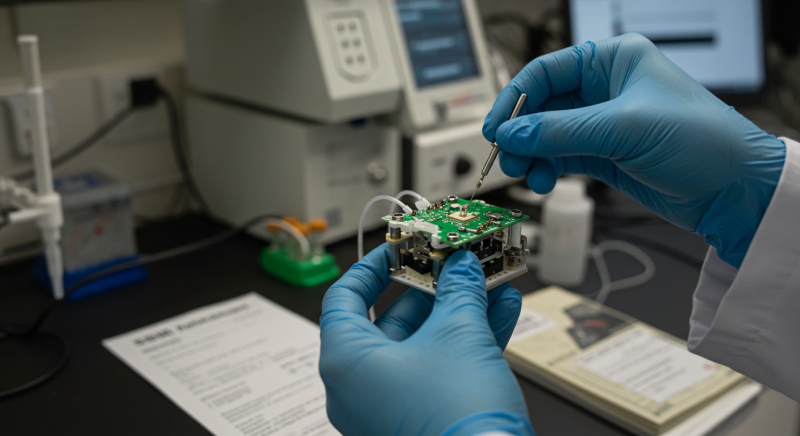Imagine pouring your heart and soul into a groundbreaking technology that could transform healthcare, clean energy, or defense. You’ve burned countless midnight oil refining your idea, only to face the crippling reality of tight budgets and investor hesitancy. Then, the promise of SBIR grants for USA startups appears—an opportunity to secure life-changing, non-dilutive funding that validates your vision and propels your innovation into the marketplace.
Key Takeaways
In this guide you’ll grasp how SBIR grants for USA startups allocate over $4.3 billion annually across Phase I and Phase II awards, with success rates ranging from 15% to 25% by agency. You’ll master the three-phase application process, learn Phase I strategies to validate feasibility, and see how to leverage Phase II and Phase III for commercialization. You’ll also uncover transition and commercialization benchmarks—such as the 25% Phase I-to-Phase II award ratio—and insider tips to boost your competitiveness.

What Are SBIR Grants?
The Small Business Innovation Research (SBIR) program, also known as America’s Seed Fund, is a congressionally mandated initiative requiring federal agencies to set aside at least 3.2% of extramural R&D budgets to support small businesses SBIR.gov. Since inception, SBIR has funneled billions into startups developing high-impact technologies. Participating agencies—from NIH to DOE—manage their own solicitations under broad federal guidelines SBIR.gov.
Funding Trends and Statistics
In FY 2022, the combined SBIR/STTR awards exceeded $4.3 billion, spread across over 6,000 awards and 3,700 unique small businesses HigherGov. Recent policy updates raised maximum Phase I awards to $314,363 and Phase II awards to $2,095,748 as of October 2024 SBIR.gov, while NSF specifically allows up to $305,000 for Phase I and $1,250,000 for Phase II NSF – National Science Foundation. Phase I to Phase II transition benchmarks require at least 25% success (one Phase II for every four Phase I awards) for seasoned awardees SBIR.gov.
Eligibility: Who Can Apply ?
Any U.S.-based for-profit small business with ≤500 employees may submit Phase I proposals. For STTR, a formal collaboration with a U.S. research institution—where the small business performs ≥40% and the institution ≥30% of the work—is required SBIR.gov. Agencies often prioritize first-time awardees under 3 years old, early-stage ventures, and underrepresented founders.

Phase I: Proof of Concept
When pursuing SBIR grants for USA startups, Phase I represents the critical moment where your bold idea transforms from concept to tangible proof. During this 6–12 month stage, funding is allocated to demonstrate the scientific or technical merit of your innovation. The goal is to convince reviewers that your proposal not only fits within the agency’s mission but also addresses an unmet need in the marketplace. As the first step in the SBIR grants for USA startups journey, Phase I allows you to validate feasibility without diluting equity or taking on debt.
In preparing a Phase I proposal, focus on crafting a clear narrative that ties every experimental aim to a real-world outcome. Describe how your team’s expertise and the proposed approach will overcome key technical challenges. For SBIR grants for USA startups, agencies look for concise, achievable objectives—avoid overly ambitious goals that cannot be met in the allotted timeframe. A strong proof-of-concept plan includes well-defined technical milestones, risk‐mitigation strategies, and a roadmap for Phase II expansion.
Building credibility in Phase I often hinges on preliminary data and qualified personnel. Even modest bench or simulation results can showcase your capability to execute the work plan. Highlight the roles of each team member, from principal investigator to technical advisors, demonstrating why your startup is uniquely positioned to deliver results. By weaving the phrase SBIR grants for USA startups into descriptions of team qualifications and institutional collaborations, you reinforce your alignment with program priorities.
Equally important is a realistic budget and timeline. Itemize direct costs—such as personnel time, equipment usage, and consumables—while justifying each expense as essential to meeting Phase I objectives. A transparent budget underscores your understanding of grant management and lays the groundwork for seamless transition into Phase II. Remember that for many SBIR grants for USA startups, reviewers assess not just scientific promise but also fiscal responsibility.
Finally, approach Phase I as an opportunity to build relationships with program managers and reviewers. Seek pre-submission feedback, address concerns directly in your narrative, and structure your proposal to answer anticipated questions. A polished, professionally written submission that communicates both passion and practicality will make your proof-of-concept stand out—setting the stage for a successful SBIR journey.
Phase II: R&D Expansion
Phase II is where SBIR grants for USA startups truly accelerate innovation, extending your proof of concept into a robust research and development effort. Over a two-year period, awardees receive significant non-dilutive funding—up to $2.1 million for SBIR or $1.8 million for STTR—to refine prototypes, conduct advanced testing, and move closer to commercialization. This stage is designed to deepen technical breakthroughs from Phase I, demonstrating that your startup can scale experimental results into real-world solutions. By securing Phase II funding, SBIR grants for USA startups help bridge the “valley of death” that often halts early-stage ventures.
In crafting a Phase II proposal for SBIR grants for USA startups, you’ll expand each Phase I objective into detailed tasks with clear timelines. Your narrative should illustrate how early feasibility data transitions into targeted R&D activities—whether that’s optimizing performance parameters, integrating subsystems, or validating manufacturing processes. Explain how each technical milestone builds on prior results, and describe the criteria you’ll use to measure success. This level of clarity reassures reviewers that your startup can manage a complex project and deliver tangible outcomes within the grant period.
A critical element of Phase II is a comprehensive commercialization plan, demonstrating that SBIR grants for USA startups lead to marketable products or services. Discuss market landscape analyses, customer needs assessments, and potential regulatory hurdles. Show how you’ll engage industry partners, distributors, or end users to validate demand and refine product features. By weaving commercialization strategy into your technical plan—such as pilot studies with lead customers or collaboration agreements—you signal readiness for Phase III and beyond.
Budgeting for Phase II requires a fine balance between ambition and realism. For SBIR grants for USA startups, detail the personnel costs for researchers and engineers, outline expenses for specialized equipment or contract services, and account for materials and data analysis tools. Justify each line item by linking it directly to project objectives—whether it’s hiring a regulatory consultant to de-risk FDA submission or leasing specialized test beds for performance validation. A transparent, well-justified budget demonstrates your grasp of fiscal responsibility and project management.
Finally, treat Phase II as a collaborative journey with your agency program manager. Regularly update them on progress, seek feedback on technical hurdles, and adjust your work plan as needed. Engaging early and often shows that SBIR grants for USA startups can foster a partnership rather than a grant-only transaction. By the end of Phase II, you should not only have a refined prototype and supporting data but also a clear trajectory toward commercialization—positioning your startup to secure private investment, government contracts, or licensing deals in Phase III.

Phase III: Commercialization
Phase III represents the culmination of the SBIR journey, where groundbreaking research funded in earlier phases matures into market-ready products and services. In this stage, small businesses leverage non-SBIR capital—whether through government procurement, private investment, or licensing—to scale production, secure regulatory approvals, and establish sustainable revenue streams. With no statutory limits on award size, duration, or number of awards, Phase III offers unparalleled flexibility, extends SBIR Data Rights into commercial agreements, and opens doors for both small and large businesses to capitalize on their innovations.
Defining Phase III and SBIR Data Rights
Phase III is formally defined as an award that “derives from, extends, or completes prior SBIR effort” and is funded entirely with non-SBIR resources SBIR.gov. Crucially, Phase III awards carry SBIR Data Rights established under the 2019 SBA Policy Directive, ensuring that proprietary technical data and methodologies developed in Phases I and II remain protected in all follow-on contracts SBIR.gov. This protection is vital when engaging large prime contractors or federal agencies, as it guarantees exclusive use of your innovations for a defined period.
Commercialization Strategies and Funding Sources
In Phase III, SBIR grants for USA startups propel innovations into commercial markets by tapping into diverse funding streams. Companies often secure mission-driven agency procurements, leveraging their SBIR pedigree to compete for contracts that advance federal priorities Army SBIR. Simultaneously, many awardees attract private equity, venture capital, or strategic corporate partnerships to ramp up manufacturing and distribution sbtc.org. A robust commercialization plan addresses market segmentation, pricing models, go-to-market tactics, and regulatory pathways—such as FDA approvals for medical devices or EPA certifications for clean-tech—ensuring a clear path to revenue NCBI.
Flexibility, Duration, and Eligibility
Unlike Phases I and II, Phase III imposes no cap on award amount, duration, or business size. Small businesses successful in Phase III can receive multiple sole-source or competitive awards, with no time constraints between successive awards Army SBIR. Moreover, once a company transitions into Phase III, it may partner or subcontract with large firms without jeopardizing its SBIR lineage SBIR.gov. This flexibility allows SBIR grants for USA startups to evolve rapidly, scaling from prototype demonstration to full-scale production as market demand dictates.
Building Partnerships and Entering the Market
Achieving Phase III success demands proactive relationship-building with program managers, procurement officers, and potential commercialization partners. Regularly updating agency contacts on technical progress and addressing procurement requirements early can secure streamlined awards and favorable contracting vehicles fai.gov. Concurrently, pilot programs with anchor customers—such as defense installations, hospital systems, or utility providers—validate performance in operational settings and generate the first revenue streams required for long-term viability SBIR.gov.
By fully capitalizing on Phase III opportunities, SBIR grants for USA startups become a powerful engine for transforming federal R&D investments into impactful products and services that benefit both government missions and commercial markets.

Insider Tips for a Winning Proposal for SBIR grants for USA startups
Crafting a standout application for SBIR grants for USA startups requires more than simply following the guidelines—it demands a strategic approach that highlights your innovation’s unique value and your team’s capacity to deliver. First, immerse yourself in the specific mission topics and priorities of each participating agency. By tailoring your proposal language to echo their stated objectives and challenges, you demonstrate that your project isn’t just scientifically sound but also directly aligned with the agency’s goals for SBIR grants for USA startups. This alignment instantly elevates your submission above generic pitches and signals to reviewers that you’ve done your homework.
Well before the submission deadline, reach out to program managers to discuss your concept and solicit feedback on its fit for SBIR grants for USA startups. A brief, focused conversation can clarify key evaluation criteria and reveal nuances in the solicitation that aren’t obvious on paper. When you reference insights gained from these discussions in your narrative, you show reviewers that you’ve engaged with the agency as a partner rather than a distant applicant, improving your proposal’s credibility and strategic positioning.
Next, prioritize clarity and storytelling in your writing. Reviewers often read dozens of proposals each cycle, so formatting your application with clear section headings, concise paragraphs, and straightforward explanations will make your innovation for SBIR grants for USA startups easy to understand and memorable. Avoid dense technical jargon where possible; instead, paint a compelling picture of the problem you’re solving, the R&D steps you’ll take, and the real-world impact your startup expects to achieve. A narrative that flows logically from challenge to solution captivates reviewers and underscores your team’s vision.
Strong preliminary data and evidence of feasibility are critical for convincing reviewers that your project merits SBIR grants for USA startups. Even small-scale lab tests, pilot surveys, or prototype demonstrations can substantiate your claims and reduce perceived risk. Present these data in simple charts or tables, and explain how each result informs the next research phase. By showing that you understand both the promise and the pitfalls of your approach, you establish trust in your technical competence and project management skills.
Equally important is a realistic, well-justified budget and timeline. For SBIR grants for USA startups, every dollar and every week counts, so align your budget line items directly with project milestones. Explain why each expense—be it specialized equipment, personnel time, or professional services—is essential to achieving your objectives. A clear budget narrative reassures reviewers that you can steward federal funds responsibly and hit your technical targets on schedule.
Finally, polish your proposal with meticulous attention to formatting, compliance, and team credentials. Ensure you meet page limits, font requirements, and submission protocols precisely—administrative oversights can disqualify even the most innovative projects. Highlight key personnel by summarizing relevant experience and past successes, showing why your team is uniquely equipped to carry out the work. When you weave SBIR grants for USA startups seamlessly into descriptions of your approach, your vision, and your qualifications, you create a cohesive, compelling case that reviewers will remember long after they’ve read all the applications.
Conclusion
Securing SBIR grants for USA startups can be a transformative catalyst, providing crucial non-dilutive funding and federal validation. By understanding eligibility, mastering Phase I proof-of-concept goals, and strategically planning Phase II commercialization, your startup can join thousands of innovators who have converted research into real-world solutions.
FAQ
What is the success rate for SBIR grants?
Agency Phase I success rates range from 15% (NSF) to 25% (USTAR-assisted applicants) and Phase II transition rates average 25% across seasoned awardees WikipediaSBIR.gov.
How long does the application process take?
From solicitation release to Phase I award takes approximately 6–9 months, depending on agency review cycles.
Can I apply to multiple agencies simultaneously?
Yes. You may submit different proposals to multiple agencies if your technology aligns with their specific solicitation topics.
Are there fees or cost-sharing requirements?
Most SBIR Phase I awards require no cost share, but certain agencies (e.g., DOE) may mandate cost-sharing for Phase II. Check agency-specific solicitations.
How do I find current SBIR solicitations?
Visit SBIR.gov and select your agency of interest to view open solicitations and deadlines.
read more
10 Secrets of Job Interview Etiquette That Will Have Employers Begging You to Work for Them!
